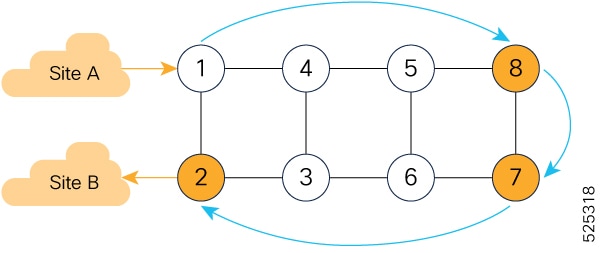Segment Routing over IPv6
Segment Routing over IPv6 (SRv6) is a network routing framework that
-
embeds routing and processing instructions directly into IPv6 packets
-
uses the Segment Routing Header (SRH) to encode these instructions
-
uses Segment Identifiers (SIDs), which are 128-bit values, to define routing and processing behaviors, and
-
enables a network programming model to allow packets to carry instructions for advanced traffic engineering and automated service chaining.
The components of Srv6 include Segment Routing Header and Segment Identifiers. See Key concepts of SRv6.
Key difference between SR-MPLS and SRv6
The table compares the key benefits and features of SR-MPLS and SRv6 to highlight their differences and advantages:
|
Feature |
SR-MPLS (Segment Routing with MPLS) |
SRv6 (Segment Routing with IPv6) |
|---|---|---|
|
Underlying technology |
Uses MPLS labels to encode segment routing paths. |
Uses IPv6 addresses (Segment Identifiers or SIDs) in IPv6 header. |
|
Packet Header |
MPLS label stack steers packets through the network. |
IPv6 extension headers carry the segment list for source routing. |
|
Scalability and flexibility |
Limited by MPLS label space and MPLS forwarding capabilities. |
Larger address space and more flexible network programming due to IPv6 extensibility. |
|
Network requirements |
Requires MPLS-enabled infrastructure. |
Requires IPv6-enabled infrastructure and SRv6 processing support. |
Benefits of SRv6
Modern networks require solutions that support growing scale, advanced services, and seamless operations. Traditional routing technologies often face limitations such as complex architectures, limited scalability, and rigid traffic management. Segment Routing over IPv6 (SRv6) addresses these challenges. It provides a highly programmable, scalable, and efficient solution by leveraging native IPv6 capabilities to simplify operations and enhance service delivery.
SRv6 delivers these key advantages:
-
Simplified network architecture: SRv6 consolidates routing functions into a single IPv6-based data plane. This eliminates multiple legacy protocols and streamlines inter-domain routing with basic IP functions and prefix summarization.
-
Native IPv6 integration and enhanced scalability: SRv6 fully leverages IPv6's capabilities and address space, ensuring long-term scalability and future readiness. Its flexible, hierarchical Segment Identifier (SID) structure efficiently scales networks, overcoming traditional label limitations and maximizing Forwarding Information Base (FIB) utilization across diverse segments.
-
Flexible and intent-based traffic engineering: SRv6 offers precise and flexible path selection through its built-in traffic engineering capabilities. This enables network programming with SIDs, supports intent-based routing via IGP Flex-Algo, and facilitates complex service chaining and Network Function Virtualization (NFV) integration.
-
Optimal load balancing: SRv6 efficiently distributes traffic across available paths. It leverages native IPv6 flow label capabilities for Equal-Cost Multi-Path (ECMP) load balancing, ensuring optimal traffic distribution based on inner packet entropy without additional protocols.
-
Unified service delivery and cloud integration: SRv6 provides a single, unified IPv6-based data plane for various services, including Virtual Private Networks (VPNs), micro-services, and cloud connectivity. It offers native support for host and cloud environments without protocol translation.
-
Seamless deployment and migration: SRv6 integrates smoothly into existing brownfield networks. It supports granular, phased adoption strategies, facilitating a seamless transition to modern network infrastructures.
-
Improved reliability and performance: SRv6 enhances network resilience with features like Fast Reroute (FRR). It also enables better Quality of Service (QoS) management through granular control over traffic paths and functions, ensuring robust and high-performing networks.
Use cases for SRv6
SRv6 is a technology that enhances various network applications through several use cases, such as:
-
Traffic engineering (TE): SRv6 optimizes network paths to enhance performance, meet SLAs, routing requirements, as well as specific needs such as security or data sovereignty.
-
Network segmentation: SRv6 enables the creation of logical network overlays, including L3VPNs and L2VPNs, over a common SRv6 underlay.
-
Simplified OPEX: By providing a common end-to-end data plane, SRv6 simplifies operations, making it easier than managing multiple technologies.


 Feedback
Feedback